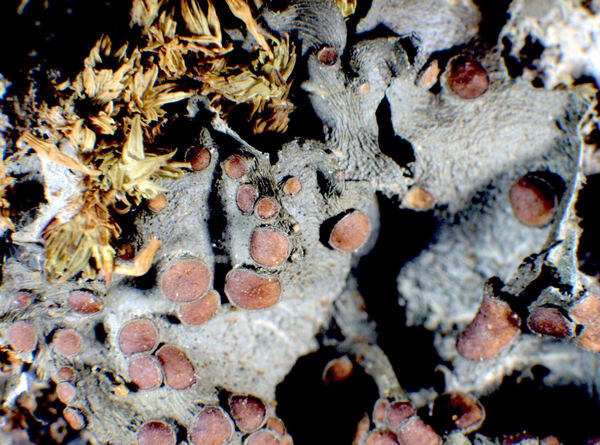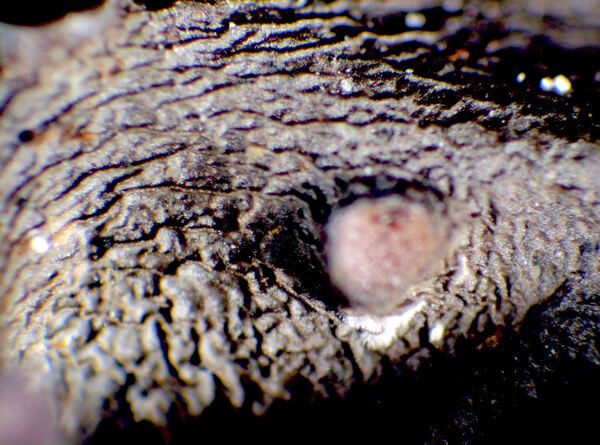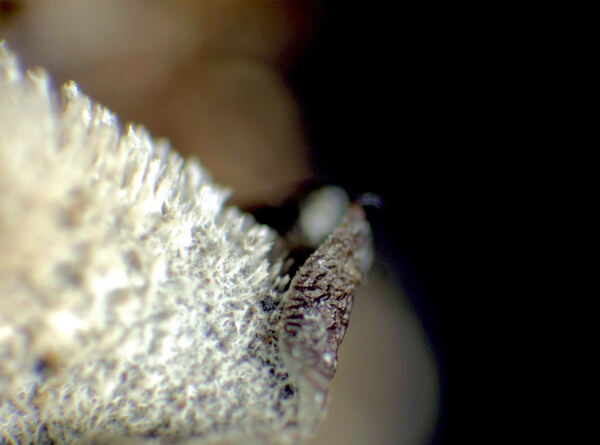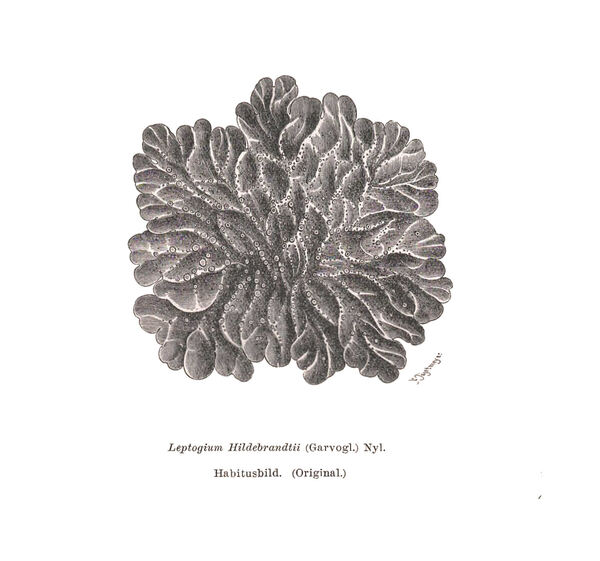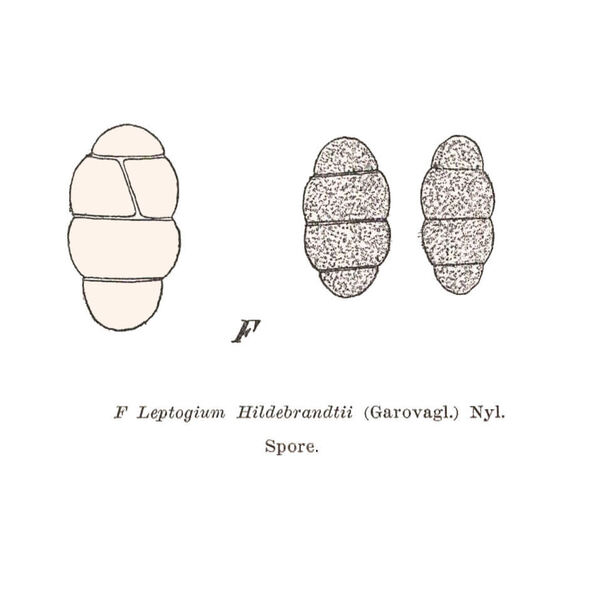Leptogium hildenbrandii (Garov.) Nyl.
Act. Soc. Linn. Bordeaux, 21: 272, 1856. Basionym: Collema hildenbrandii Garov. - Lich. Prov. Comen., 1: 3, 1837.
Synonyms: Leptogium saturninum var. complicatum Anzi
Distribution: N - Frl, Ven (Caniglia & al. 1999), TAA (Nascimbene & al. 2007b), Lomb (Rivellini 1994, Tretiach 1996, Arosio & al. 2003, Dalle Vedove & al. 2004, Abramini & al. 2008, Ravera & al. 2021c), Piem (Isocrono & al. 2004), VA (Piervittori & Isocrono 1999), Emil (Fariselli & al. 2020). C - Marc, Umb (Genovesi & al. 2002, Ravera & al. 2006, 2006b), Abr (Olivieri & Pacioni 1996, Olivieri & al. 1997, 1997b, Loppi & al. 1999, Brackel 2015, Gheza & al. 2021). S - Bas, Cal (Puntillo 1996).
Description: Thallus foliose, broad-lobed, homoiomerous, gelatinous when wet, firm and markedly rigid when dry, rather loosely adnate, forming large, more or less regular, 5-10(-13) cm wide rosettes. Lobes 5-10(-12) mm wide, 245-325 μm thick, contiguous or more or less imbricate, with rounded, ear-like apices, 70-150 µm thick. Upper surface brown-black or dark lead-grey, greenish brown when moist, minutely and irregularly but conspicuously wrinkled and striate. Lower surface white-tomentose, with 60-120 μm long hairs of cylindrical cells measuring 8-15 x 3-5 μm, and tufts of pale hapters. Upper and lower cortex formed by a single layer of 6-9 μm wide, angular cells, inner part of thallus with loosely interwoven chains of Nostoc and hyphae. Apothecia usually abundant, especially in the central parts, lecanorine, laminal, at first immersed in the thallus, then sessile and constricvted at base, 2-4(-6) mm across, with a brown-red, shiny disc and a grey-brown, rather thin, usually rugose thalline margin. Exciple euparaplectenchymatous; epithecium pale brown; hymenium colourless, I+ blue; paraphyses simple, 1-2.5 µm thick at mid-level, the apical cells slightly swollen; hypothecium colourless or pale yellow. Asci 8-spored, cylindrical-clavate, the apex strongly thickened, the apical dome K/I+ pale blue, with a downwardly projecting K/I+ deep blue tubular structure. Ascospores submuriform, hyaline, ellipsoid, 16-24(-26) x 8-10 µm. Pycnidia immersed, marginal to submarginal, 0.1-0.3 mm across. Conidia bacilliform, with swollen apices, 4.3-5.5 x 1.3-1.6 µm. Photobiont cyanobacterial (Nostoc, the cells in long chains of 12-16). Spot tests: all negative. Chemistry: without lichen substances.Note: on isolated tress with base-rich bark, especially Juglans, Fraxinus and Populus in humid valleys with a rather continental climate. It is included in the Italian red list of epiphytic lichens as “Near-threatened” (Nascimbene & al. 2013c).
Growth form: Foliose, broad lobed
Substrata: bark
Photobiont: cyanobacteria, filamentous (e.g. Nostoc, Scytonema)
Reproductive strategy: mainly sexual
Most common in areas with a humid-warm climate (e.g. most of Tyrrenian Italy)
Commonnes-rarity: (info)
Alpine belt: absent
Subalpine belt: absent
Oromediterranean belt: absent
Montane belt: absent
Submediterranean belt: very rare
Padanian area: absent
Humid submediterranean belt: extremely rare
Humid mediterranean belt: absent
Dry mediterranean belt: absent

Predictive model
Herbarium samples
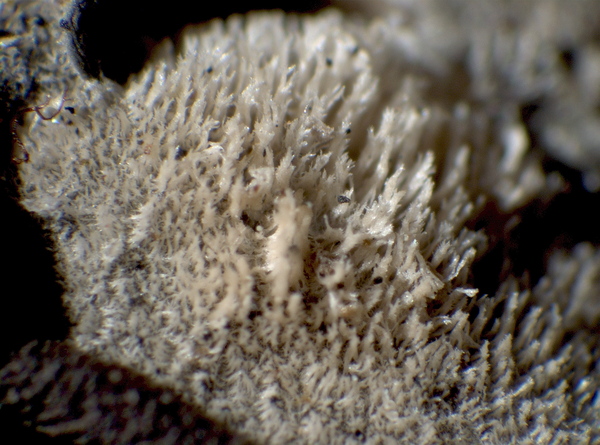

E. Pittao; Owner: Department of Life Sciences, University of Trieste
Herbarium: TSB (16637)
2008.03.10
lower surface
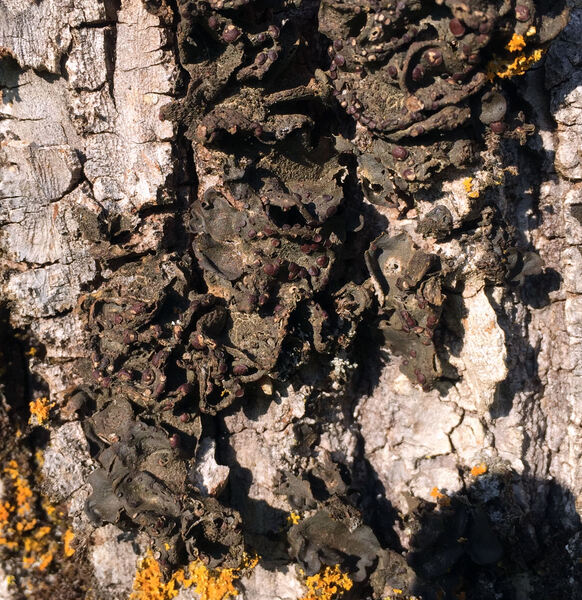

P.L. Nimis; Owner: Department of Life Sciences, University of Trieste
Italy, Friuli Venezia Giulia, Udine, Ampezzo Carnico, 600 m
09.09.2016
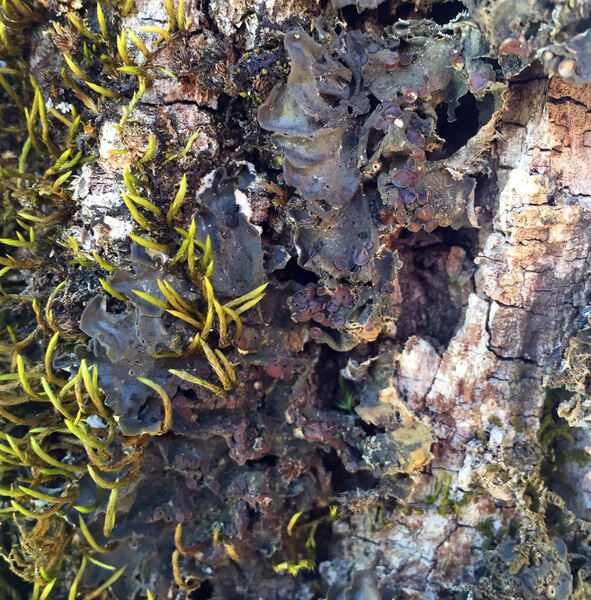

P.L. Nimis; Owner: Department of Life Sciences, University of Trieste
Italy, Friuli Venezia Giulia, Udine, Ampezzo Carnico, 600 m
09.09.2016
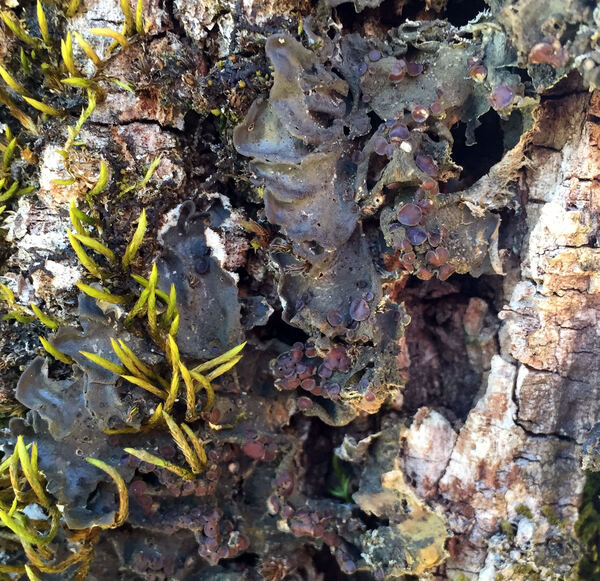

P.L. Nimis; Owner: Department of Life Sciences, University of Trieste
Italy, Friuli Venezia Giulia, Udine, Ampezzo Carnico, 600 m
09.09.2016
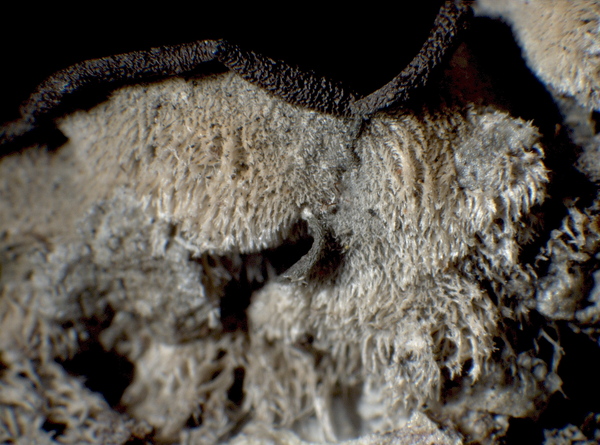

E. Pittao; Owner: Department of Life Sciences, University of Trieste
Herbarium: TSB (16637)
2008.03.10
lower surface

Courtesy Danièle et Olivier Gonnet - Source: https://www.afl-lichenologie.fr/Photos_AFL/Photos_AFL_L/Leptogium_hildenbrandii.htm
France, session AFL Luberon 2009 - Vaucluse

Jacques Haine - Source: http://www.lichensmaritimes.org/index.php?task=fiche&lichen=560&lang=en
France, Drôme Remuzat
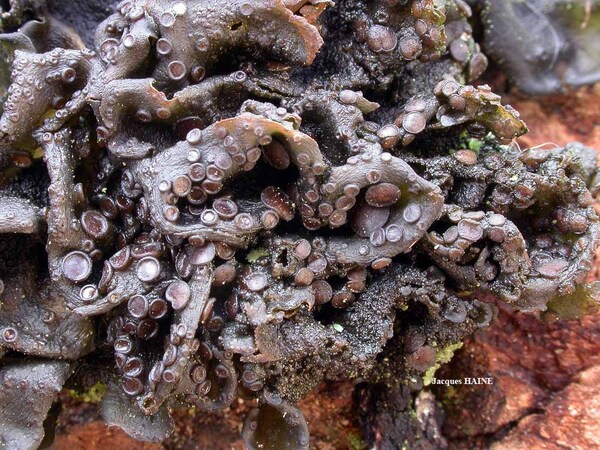
Jacques Haine - Source: http://www.lichensmaritimes.org/index.php?task=fiche&lichen=560&lang=en
France, Drôme Remuzat
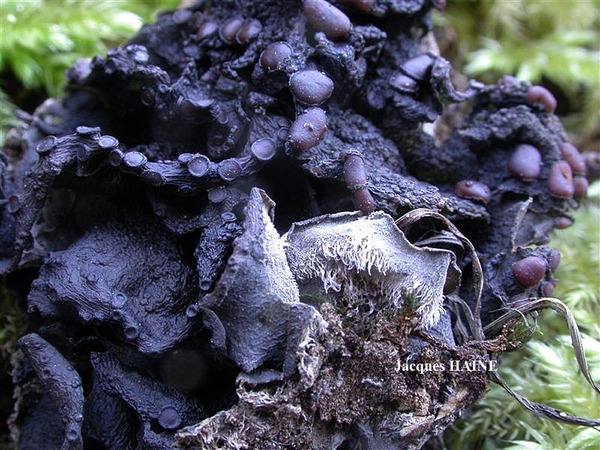
Jacques Haine - Source: http://www.lichensmaritimes.org/index.php?task=fiche&lichen=560&lang=en
France, Drôme Remuzat
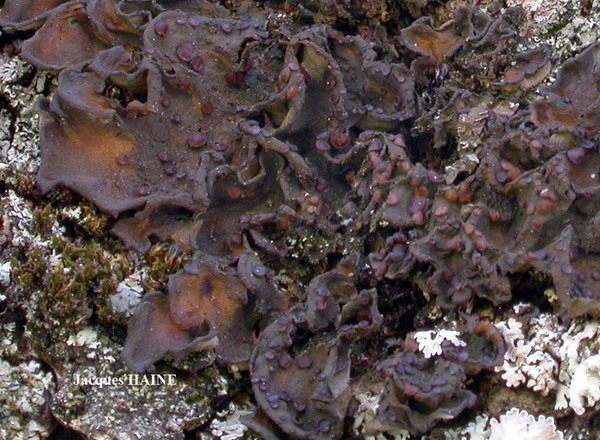
Jacques Haine - Source: http://www.lichensmaritimes.org/index.php?task=fiche&lichen=560&lang=en
France, Drôme Remuzat
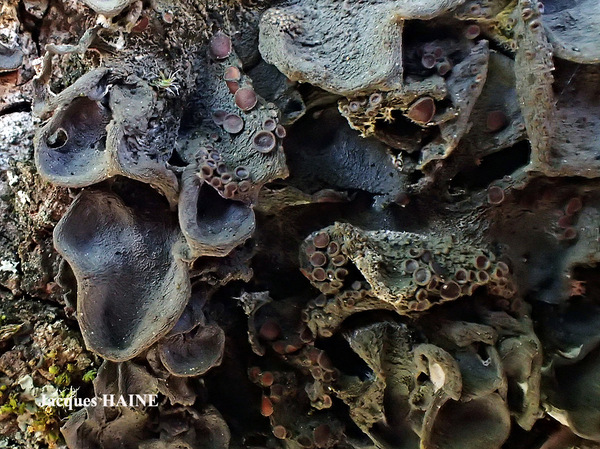
Jacques Haine - Source: http://www.lichensmaritimes.org/index.php?task=fiche&lichen=560&lang=en
France, Drôme Remuzat
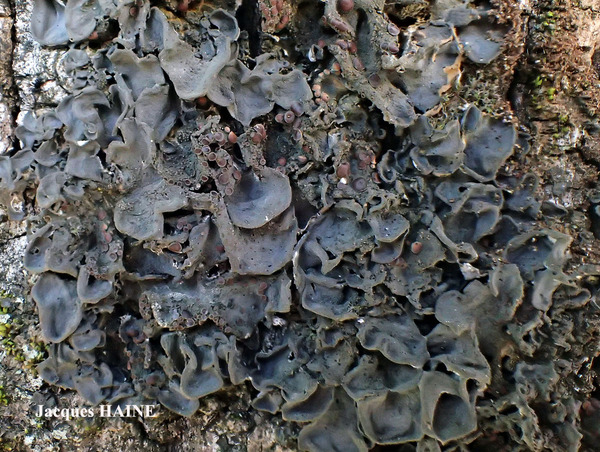
Jacques Haine - Source: http://www.lichensmaritimes.org/index.php?task=fiche&lichen=560&lang=en
France, Drôme Remuzat
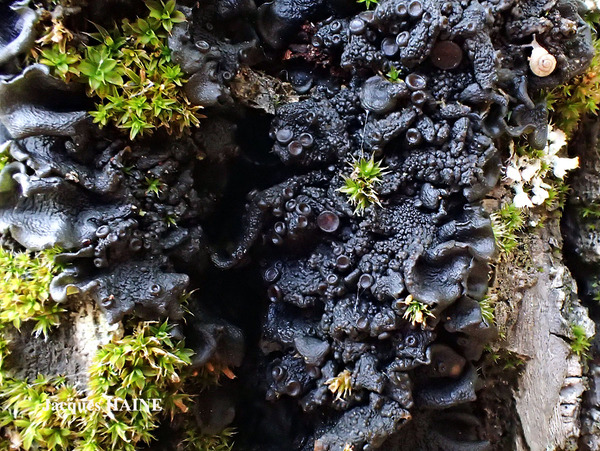
Jacques Haine - Source: http://www.lichensmaritimes.org/index.php?task=fiche&lichen=560&lang=en
France, Drôme Remuzat
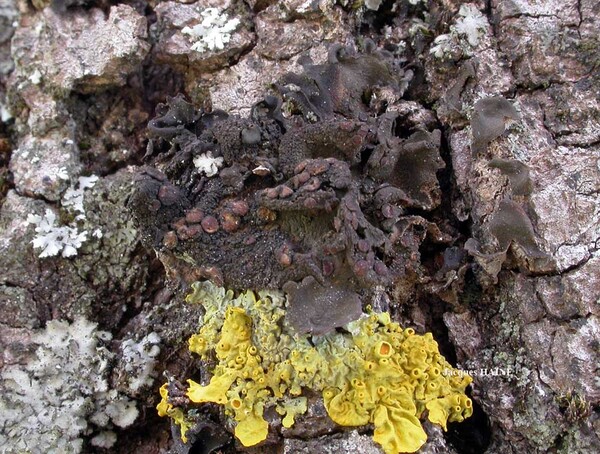
Jacques Haine - Source: http://www.lichensmaritimes.org/index.php?task=fiche&lichen=560&lang=en
France, Drôme Remuzat
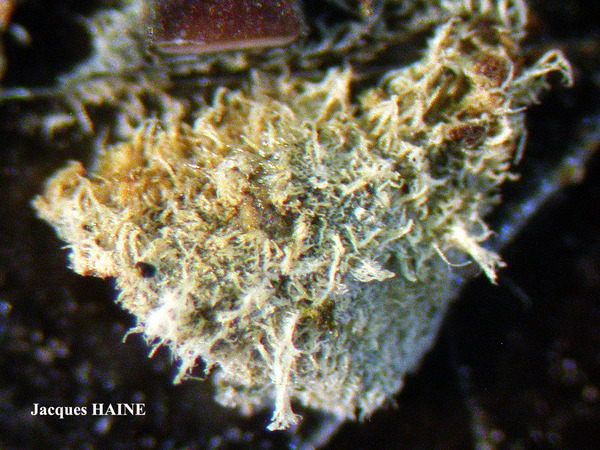
Jacques Haine - Source: http://www.lichensmaritimes.org/index.php?task=fiche&lichen=560&lang=en
France, Drôme Remuzat
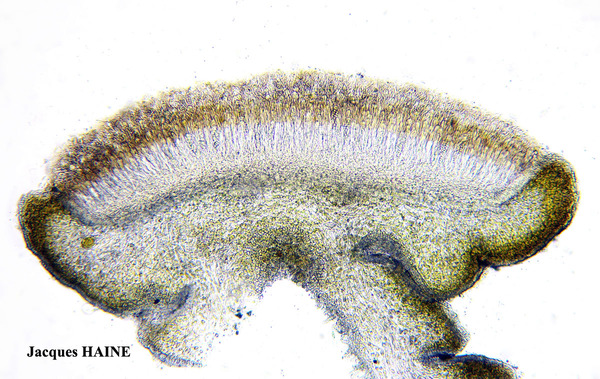
Jacques Haine - Source: http://www.lichensmaritimes.org/index.php?task=fiche&lichen=560&lang=en
France, Drôme Remuzat
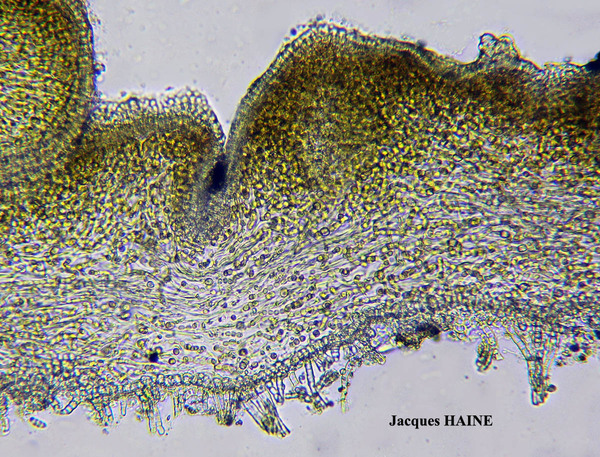
Jacques Haine - Source: http://www.lichensmaritimes.org/index.php?task=fiche&lichen=560&lang=en
France, Drôme Remuzat
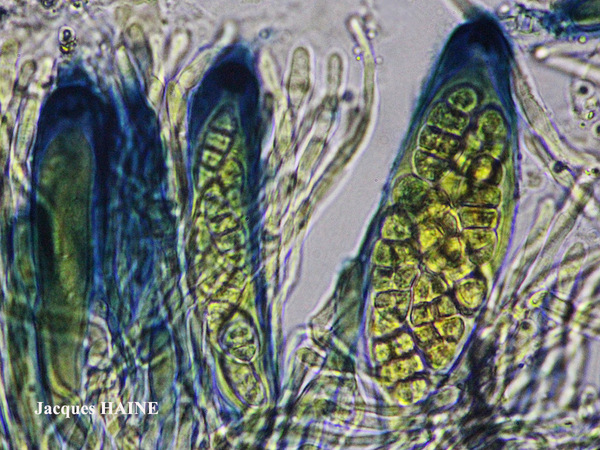
Jacques Haine - Source: http://www.lichensmaritimes.org/index.php?task=fiche&lichen=560&lang=en
France, Drôme Remuzat

Jacques Haine - Source: http://www.lichensmaritimes.org/index.php?task=fiche&lichen=560&lang=en
France, Drôme Remuzat
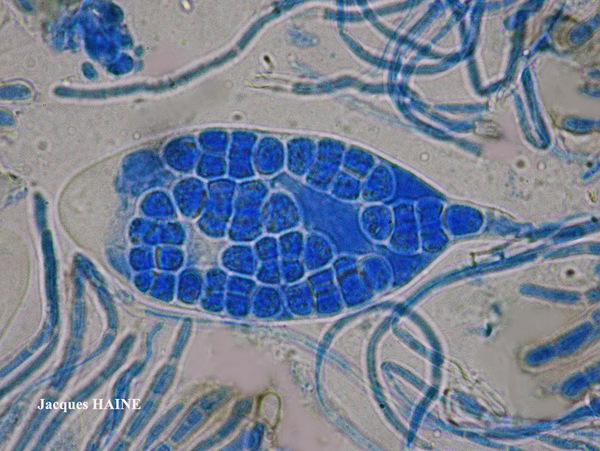
Jacques Haine - Source: http://www.lichensmaritimes.org/index.php?task=fiche&lichen=560&lang=en
France, Drôme Remuzat
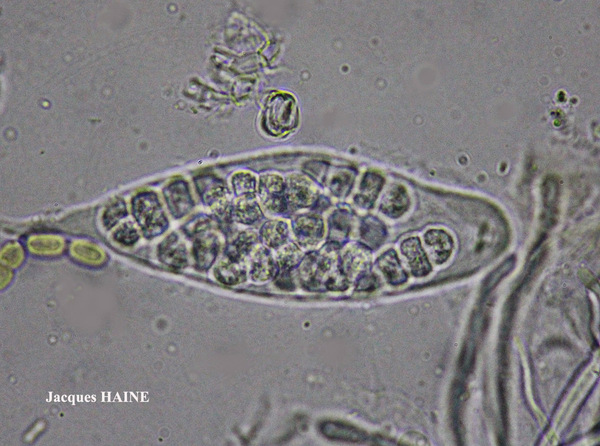
Jacques Haine - Source: http://www.lichensmaritimes.org/index.php?task=fiche&lichen=560&lang=en
France, Drôme Remuzat
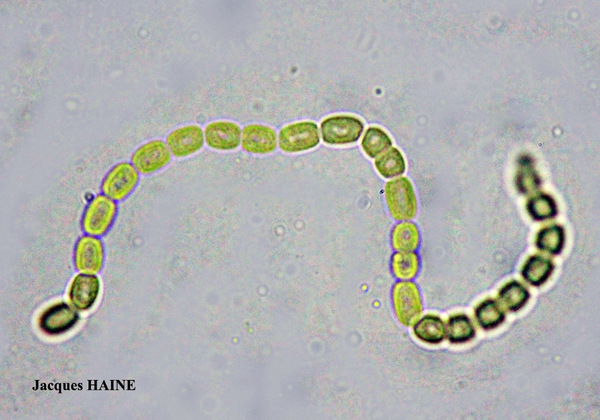
Jacques Haine - Source: http://www.lichensmaritimes.org/index.php?task=fiche&lichen=560&lang=en
France, Drôme Remuzat
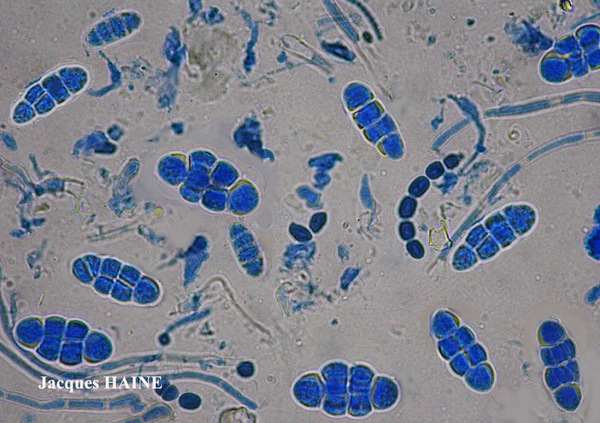
Jacques Haine - Source: http://www.lichensmaritimes.org/index.php?task=fiche&lichen=560&lang=en
France, Drôme Remuzat
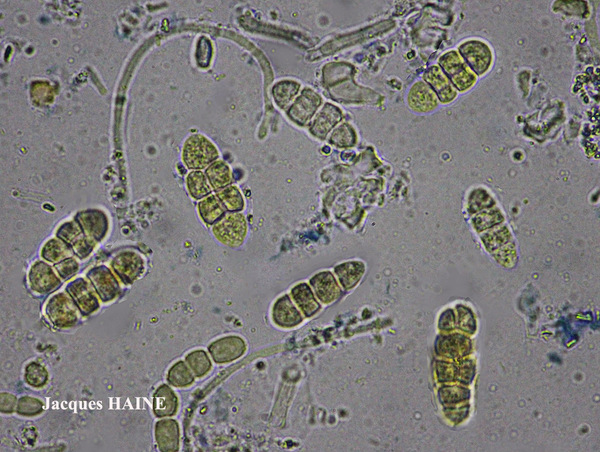
Jacques Haine - Source: http://www.lichensmaritimes.org/index.php?task=fiche&lichen=560&lang=en
France, Drôme Remuzat
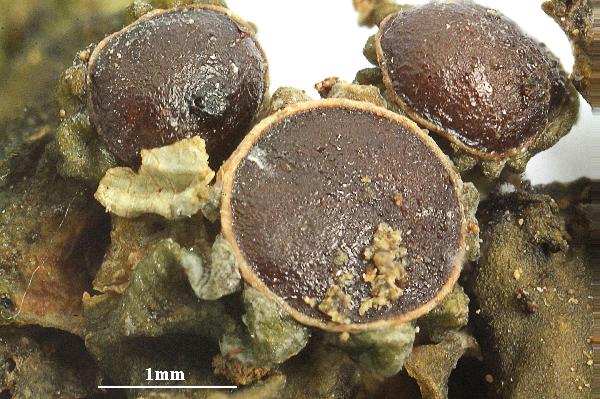

Felix Schumm - CC BY-SA 4.0
[6283], Philippinen, Mindanao, Provinz Bukidnon, westlich Malabalay,
tropischer Regenwald am Mt. Kitanglad ab Zwischen-Campsite ,
08°09.637 N, 124°55.871 E, alt.: 1870-2800 m. Leg. F. Schumm & U.
Schwarz, 19.08.1999, det. A. Aptroot 2009.
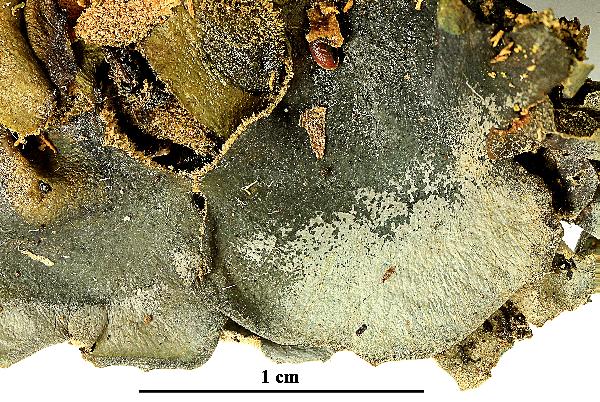

Felix Schumm - CC BY-SA 4.0
[6283], Philippinen, Mindanao, Provinz Bukidnon, westlich Malabalay,
tropischer Regenwald am Mt. Kitanglad ab Zwischen-Campsite ,
08°09.637 N, 124°55.871 E, alt.: 1870-2800 m. Leg. F. Schumm & U.
Schwarz, 19.08.1999, det. A. Aptroot 2009.


Felix Schumm - CC BY-SA 4.0
[6283], Philippinen, Mindanao, Provinz Bukidnon, westlich Malabalay,
tropischer Regenwald am Mt. Kitanglad ab Zwischen-Campsite ,
08°09.637 N, 124°55.871 E, alt.: 1870-2800 m. Leg. F. Schumm & U.
Schwarz, 19.08.1999, det. A. Aptroot 2009.
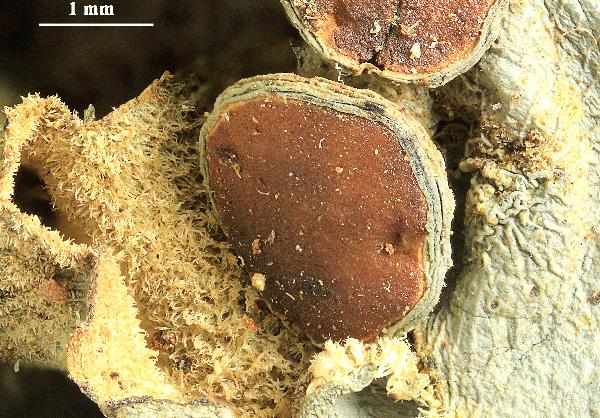

Felix Schumm - CC BY-SA 4.0
[6320], Philippinen, Mindanao, Provinz Bukidnon, westlich Malabalay,
tropischer Regenwald am Mt. Kitanglad ab Zwischen-Campsite ,
08°09.637 N, 124°55.871 E, 1870-2800 m. Leg. F. Schumm & U.
Schwarz, 19.08.1999, det. A. Aptroot, 2009.
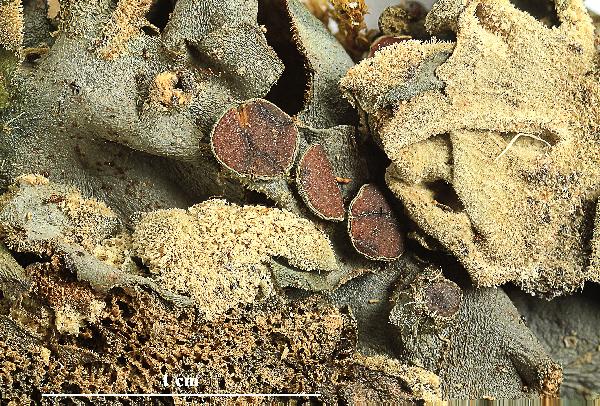

Felix Schumm - CC BY-SA 4.0
[6320], Philippinen, Mindanao, Provinz Bukidnon, westlich Malabalay,
tropischer Regenwald am Mt. Kitanglad ab Zwischen-Campsite ,
08°09.637 N, 124°55.871 E, 1870-2800 m. Leg. F. Schumm & U.
Schwarz, 19.08.1999, det. A. Aptroot, 2009.
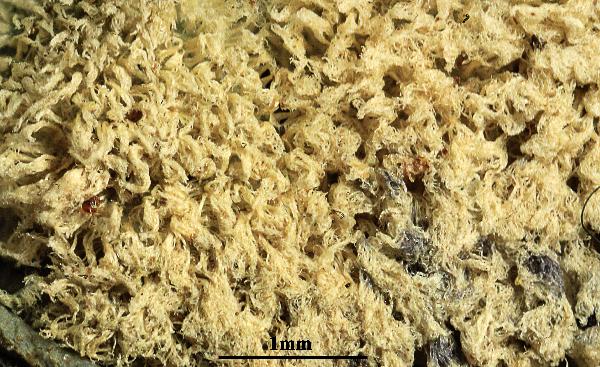

Felix Schumm - CC BY-SA 4.0
[6320], Philippinen, Mindanao, Provinz Bukidnon, westlich Malabalay,
tropischer Regenwald am Mt. Kitanglad ab Zwischen-Campsite ,
08°09.637 N, 124°55.871 E, 1870-2800 m. Leg. F. Schumm & U.
Schwarz, 19.08.1999, det. A. Aptroot, 2009.
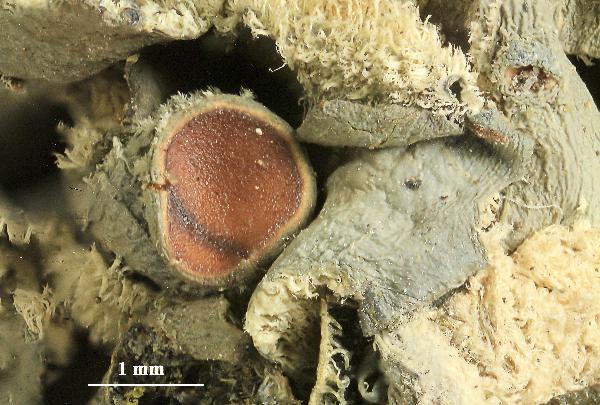

Felix Schumm - CC BY-SA 4.0
[6320], Philippinen, Mindanao, Provinz Bukidnon, westlich Malabalay,
tropischer Regenwald am Mt. Kitanglad ab Zwischen-Campsite ,
08°09.637 N, 124°55.871 E, 1870-2800 m. Leg. F. Schumm & U.
Schwarz, 19.08.1999, det. A. Aptroot, 2009.
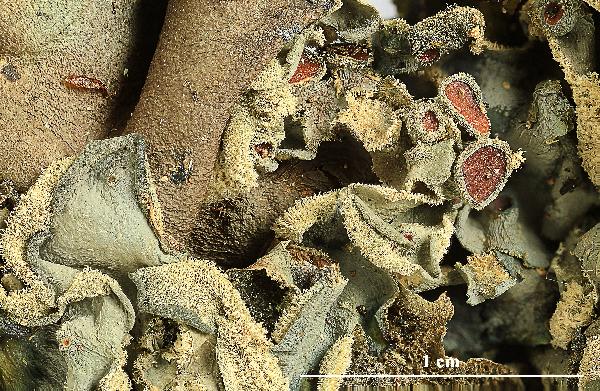

Felix Schumm - CC BY-SA 4.0
[6320], Philippinen, Mindanao, Provinz Bukidnon, westlich Malabalay,
tropischer Regenwald am Mt. Kitanglad ab Zwischen-Campsite ,
08°09.637 N, 124°55.871 E, 1870-2800 m. Leg. F. Schumm & U.
Schwarz, 19.08.1999, det. A. Aptroot, 2009.


Felix Schumm - CC BY-SA 4.0
[VZ2434], Italia. Carnica: montes Alpi Carniche, distr. Ampezzo: secus
viam inter urbem Ampezzo et transitum Fasso Pura, 500 m. Ad corticem
arboris (Juglans regia) in prato. Leg. F. Ceni & A. V zda,
27.09.1990. - EX A. V ZDA: LICHENES SELECTI EXSICCATI NR. 1926.
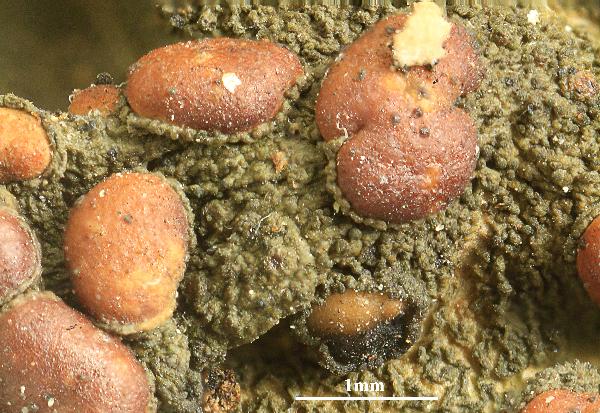

Felix Schumm - CC BY-SA 4.0
[VZ2434], Italia. Carnica: montes Alpi Carniche, distr. Ampezzo: secus
viam inter urbem Ampezzo et transitum Fasso Pura, 500 m. Ad corticem
arboris (Juglans regia) in prato. Leg. F. Ceni & A. V zda,
27.09.1990. - EX A. V ZDA: LICHENES SELECTI EXSICCATI NR. 1926.
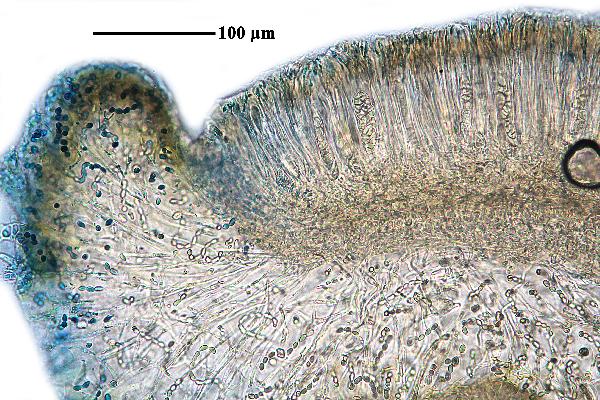

Felix Schumm - CC BY-SA 4.0
[VZ2434], Italia. Carnica: montes Alpi Carniche, distr. Ampezzo: secus
viam inter urbem Ampezzo et transitum Fasso Pura, 500 m. Ad corticem
arboris (Juglans regia) in prato. Leg. F. Ceni & A. V zda,
27.09.1990. - EX A. V ZDA: LICHENES SELECTI EXSICCATI NR. 1926.


Felix Schumm - CC BY-SA 4.0
[VZ2434], Italia. Carnica: montes Alpi Carniche, distr. Ampezzo: secus
viam inter urbem Ampezzo et transitum Fasso Pura, 500 m. Ad corticem
arboris (Juglans regia) in prato. Leg. F. Ceni & A. V zda,
27.09.1990. - EX A. V ZDA: LICHENES SELECTI EXSICCATI NR. 1926.
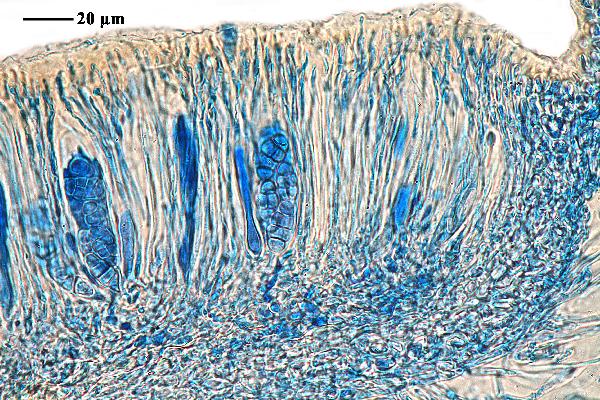

Felix Schumm - CC BY-SA 4.0
[VZ2434], Italia. Carnica: montes Alpi Carniche, distr. Ampezzo: secus
viam inter urbem Ampezzo et transitum Fasso Pura, 500 m. Ad corticem
arboris (Juglans regia) in prato. Leg. F. Ceni & A. V zda,
27.09.1990. - EX A. V ZDA: LICHENES SELECTI EXSICCATI NR. 1926.
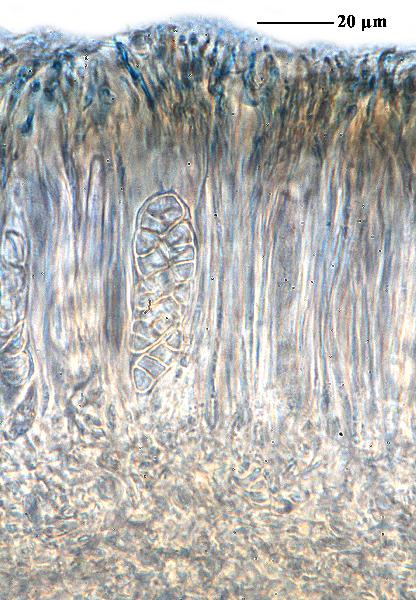

Felix Schumm - CC BY-SA 4.0
[VZ2434], Italia. Carnica: montes Alpi Carniche, distr. Ampezzo: secus
viam inter urbem Ampezzo et transitum Fasso Pura, 500 m. Ad corticem
arboris (Juglans regia) in prato. Leg. F. Ceni & A. V zda,
27.09.1990. - EX A. V ZDA: LICHENES SELECTI EXSICCATI NR. 1926.


Felix Schumm - CC BY-SA 4.0
[VZ2434], Italia. Carnica: montes Alpi Carniche, distr. Ampezzo: secus
viam inter urbem Ampezzo et transitum Fasso Pura, 500 m. Ad corticem
arboris (Juglans regia) in prato. Leg. F. Ceni & A. V zda,
27.09.1990. - EX A. V ZDA: LICHENES SELECTI EXSICCATI NR. 1926.


Felix Schumm - CC BY-SA 4.0
[VZ2434], Italia. Carnica: montes Alpi Carniche, distr. Ampezzo: secus
viam inter urbem Ampezzo et transitum Fasso Pura, 500 m. Ad corticem
arboris (Juglans regia) in prato. Leg. F. Ceni & A. V zda,
27.09.1990. - EX A. V ZDA: LICHENES SELECTI EXSICCATI NR. 1926.
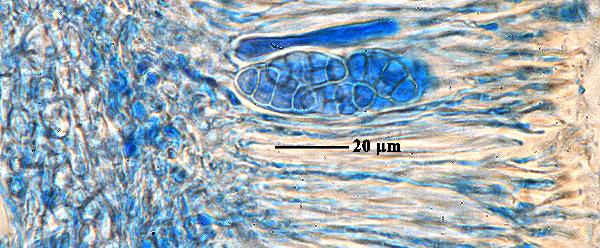

Felix Schumm - CC BY-SA 4.0
[VZ2434], Italia. Carnica: montes Alpi Carniche, distr. Ampezzo: secus
viam inter urbem Ampezzo et transitum Fasso Pura, 500 m. Ad corticem
arboris (Juglans regia) in prato. Leg. F. Ceni & A. V zda,
27.09.1990. - EX A. V ZDA: LICHENES SELECTI EXSICCATI NR. 1926.
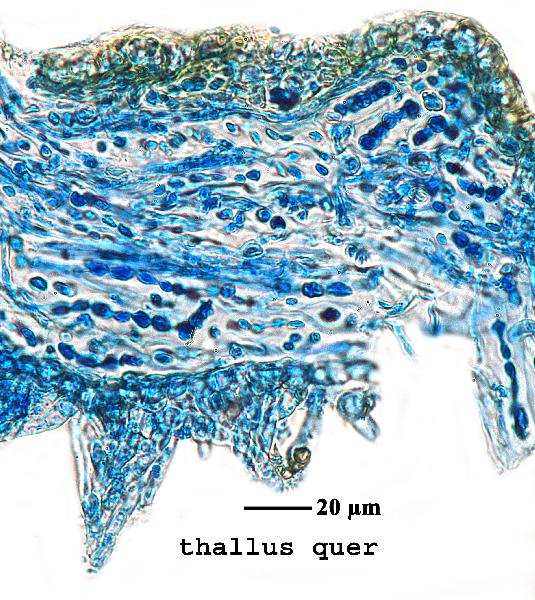

Felix Schumm - CC BY-SA 4.0
[VZ2434], Italia. Carnica: montes Alpi Carniche, distr. Ampezzo: secus
viam inter urbem Ampezzo et transitum Fasso Pura, 500 m. Ad corticem
arboris (Juglans regia) in prato. Leg. F. Ceni & A. V zda,
27.09.1990. - EX A. V ZDA: LICHENES SELECTI EXSICCATI NR. 1926.


Felix Schumm - CC BY-SA 4.0
[VZ2434], Italia. Carnica: montes Alpi Carniche, distr. Ampezzo: secus
viam inter urbem Ampezzo et transitum Fasso Pura, 500 m. Ad corticem
arboris (Juglans regia) in prato. Leg. F. Ceni & A. V zda,
27.09.1990. - EX A. V ZDA: LICHENES SELECTI EXSICCATI NR. 1926.
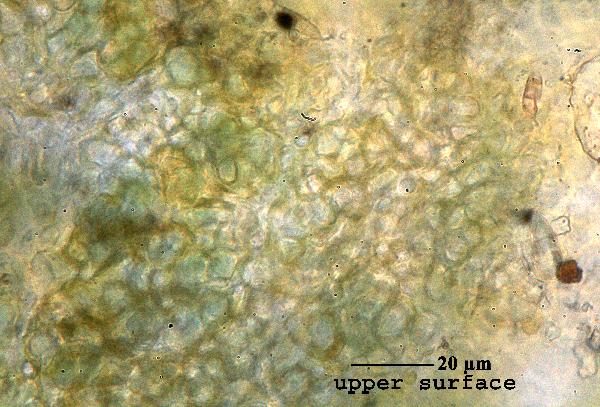

Felix Schumm - CC BY-SA 4.0
[VZ2434], Italia. Carnica: montes Alpi Carniche, distr. Ampezzo: secus
viam inter urbem Ampezzo et transitum Fasso Pura, 500 m. Ad corticem
arboris (Juglans regia) in prato. Leg. F. Ceni & A. V zda,
27.09.1990. - EX A. V ZDA: LICHENES SELECTI EXSICCATI NR. 1926.

Collezione lichenologica Abramo Massalongo del Museo di Storia Naturale G. Ligabue di Venezia - Autori: Seggi, Linda; Trabucco, Raffaella Proprietà: Fondazione Musei Civici di Venezia - CC BY-NC
Italy, Veneto, Ad Aceris truncos in opp. Tregnago 1855
as Mallotium hildenbrandii
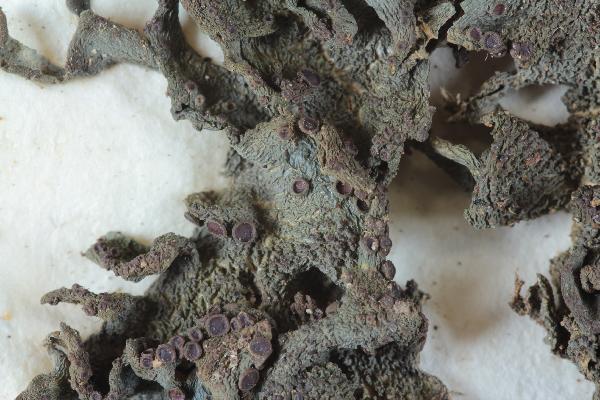
Collezione lichenologica Abramo Massalongo del Museo di Storia Naturale G. Ligabue di Venezia - Autori: Seggi, Linda; Trabucco, Raffaella Proprietà: Fondazione Musei Civici di Venezia - CC BY-NC
Italy, Veneto, Ad Aceris truncos in opp. Tregnago 1855
as Mallotium hildenbrandii
Growth form: Foliose, broad lobed
Substrata: bark
Photobiont: cyanobacteria, filamentous (e.g. Nostoc, Scytonema)
Reproductive strategy: mainly sexual
Most common in areas with a humid-warm climate (e.g. most of Tyrrenian Italy)
Commonnes-rarity: (info)
Alpine belt: absent
Subalpine belt: absent
Oromediterranean belt: absent
Montane belt: absent
Submediterranean belt: very rare
Padanian area: absent
Humid submediterranean belt: extremely rare
Humid mediterranean belt: absent
Dry mediterranean belt: absent

Predictive model
| Herbarium samples |


E. Pittao; Owner: Department of Life Sciences, University of Trieste
Herbarium: TSB (16637)
2008.03.10
lower surface


P.L. Nimis; Owner: Department of Life Sciences, University of Trieste
Italy, Friuli Venezia Giulia, Udine, Ampezzo Carnico, 600 m
09.09.2016


P.L. Nimis; Owner: Department of Life Sciences, University of Trieste
Italy, Friuli Venezia Giulia, Udine, Ampezzo Carnico, 600 m
09.09.2016


P.L. Nimis; Owner: Department of Life Sciences, University of Trieste
Italy, Friuli Venezia Giulia, Udine, Ampezzo Carnico, 600 m
09.09.2016


E. Pittao; Owner: Department of Life Sciences, University of Trieste
Herbarium: TSB (16637)
2008.03.10
lower surface

Courtesy Danièle et Olivier Gonnet - Source: https://www.afl-lichenologie.fr/Photos_AFL/Photos_AFL_L/Leptogium_hildenbrandii.htm
France, session AFL Luberon 2009 - Vaucluse

Jacques Haine - Source: http://www.lichensmaritimes.org/index.php?task=fiche&lichen=560&lang=en
France, Drôme Remuzat

Jacques Haine - Source: http://www.lichensmaritimes.org/index.php?task=fiche&lichen=560&lang=en
France, Drôme Remuzat

Jacques Haine - Source: http://www.lichensmaritimes.org/index.php?task=fiche&lichen=560&lang=en
France, Drôme Remuzat

Jacques Haine - Source: http://www.lichensmaritimes.org/index.php?task=fiche&lichen=560&lang=en
France, Drôme Remuzat

Jacques Haine - Source: http://www.lichensmaritimes.org/index.php?task=fiche&lichen=560&lang=en
France, Drôme Remuzat

Jacques Haine - Source: http://www.lichensmaritimes.org/index.php?task=fiche&lichen=560&lang=en
France, Drôme Remuzat

Jacques Haine - Source: http://www.lichensmaritimes.org/index.php?task=fiche&lichen=560&lang=en
France, Drôme Remuzat

Jacques Haine - Source: http://www.lichensmaritimes.org/index.php?task=fiche&lichen=560&lang=en
France, Drôme Remuzat

Jacques Haine - Source: http://www.lichensmaritimes.org/index.php?task=fiche&lichen=560&lang=en
France, Drôme Remuzat

Jacques Haine - Source: http://www.lichensmaritimes.org/index.php?task=fiche&lichen=560&lang=en
France, Drôme Remuzat

Jacques Haine - Source: http://www.lichensmaritimes.org/index.php?task=fiche&lichen=560&lang=en
France, Drôme Remuzat

Jacques Haine - Source: http://www.lichensmaritimes.org/index.php?task=fiche&lichen=560&lang=en
France, Drôme Remuzat

Jacques Haine - Source: http://www.lichensmaritimes.org/index.php?task=fiche&lichen=560&lang=en
France, Drôme Remuzat

Jacques Haine - Source: http://www.lichensmaritimes.org/index.php?task=fiche&lichen=560&lang=en
France, Drôme Remuzat

Jacques Haine - Source: http://www.lichensmaritimes.org/index.php?task=fiche&lichen=560&lang=en
France, Drôme Remuzat

Jacques Haine - Source: http://www.lichensmaritimes.org/index.php?task=fiche&lichen=560&lang=en
France, Drôme Remuzat

Jacques Haine - Source: http://www.lichensmaritimes.org/index.php?task=fiche&lichen=560&lang=en
France, Drôme Remuzat

Jacques Haine - Source: http://www.lichensmaritimes.org/index.php?task=fiche&lichen=560&lang=en
France, Drôme Remuzat


Felix Schumm - CC BY-SA 4.0
[6283], Philippinen, Mindanao, Provinz Bukidnon, westlich Malabalay, tropischer Regenwald am Mt. Kitanglad ab Zwischen-Campsite , 08°09.637 N, 124°55.871 E, alt.: 1870-2800 m. Leg. F. Schumm & U. Schwarz, 19.08.1999, det. A. Aptroot 2009.


Felix Schumm - CC BY-SA 4.0
[6283], Philippinen, Mindanao, Provinz Bukidnon, westlich Malabalay, tropischer Regenwald am Mt. Kitanglad ab Zwischen-Campsite , 08°09.637 N, 124°55.871 E, alt.: 1870-2800 m. Leg. F. Schumm & U. Schwarz, 19.08.1999, det. A. Aptroot 2009.


Felix Schumm - CC BY-SA 4.0
[6283], Philippinen, Mindanao, Provinz Bukidnon, westlich Malabalay, tropischer Regenwald am Mt. Kitanglad ab Zwischen-Campsite , 08°09.637 N, 124°55.871 E, alt.: 1870-2800 m. Leg. F. Schumm & U. Schwarz, 19.08.1999, det. A. Aptroot 2009.


Felix Schumm - CC BY-SA 4.0
[6320], Philippinen, Mindanao, Provinz Bukidnon, westlich Malabalay, tropischer Regenwald am Mt. Kitanglad ab Zwischen-Campsite , 08°09.637 N, 124°55.871 E, 1870-2800 m. Leg. F. Schumm & U. Schwarz, 19.08.1999, det. A. Aptroot, 2009.


Felix Schumm - CC BY-SA 4.0
[6320], Philippinen, Mindanao, Provinz Bukidnon, westlich Malabalay, tropischer Regenwald am Mt. Kitanglad ab Zwischen-Campsite , 08°09.637 N, 124°55.871 E, 1870-2800 m. Leg. F. Schumm & U. Schwarz, 19.08.1999, det. A. Aptroot, 2009.


Felix Schumm - CC BY-SA 4.0
[6320], Philippinen, Mindanao, Provinz Bukidnon, westlich Malabalay, tropischer Regenwald am Mt. Kitanglad ab Zwischen-Campsite , 08°09.637 N, 124°55.871 E, 1870-2800 m. Leg. F. Schumm & U. Schwarz, 19.08.1999, det. A. Aptroot, 2009.


Felix Schumm - CC BY-SA 4.0
[6320], Philippinen, Mindanao, Provinz Bukidnon, westlich Malabalay, tropischer Regenwald am Mt. Kitanglad ab Zwischen-Campsite , 08°09.637 N, 124°55.871 E, 1870-2800 m. Leg. F. Schumm & U. Schwarz, 19.08.1999, det. A. Aptroot, 2009.


Felix Schumm - CC BY-SA 4.0
[6320], Philippinen, Mindanao, Provinz Bukidnon, westlich Malabalay, tropischer Regenwald am Mt. Kitanglad ab Zwischen-Campsite , 08°09.637 N, 124°55.871 E, 1870-2800 m. Leg. F. Schumm & U. Schwarz, 19.08.1999, det. A. Aptroot, 2009.


Felix Schumm - CC BY-SA 4.0
[VZ2434], Italia. Carnica: montes Alpi Carniche, distr. Ampezzo: secus viam inter urbem Ampezzo et transitum Fasso Pura, 500 m. Ad corticem arboris (Juglans regia) in prato. Leg. F. Ceni & A. V zda, 27.09.1990. - EX A. V ZDA: LICHENES SELECTI EXSICCATI NR. 1926.


Felix Schumm - CC BY-SA 4.0
[VZ2434], Italia. Carnica: montes Alpi Carniche, distr. Ampezzo: secus viam inter urbem Ampezzo et transitum Fasso Pura, 500 m. Ad corticem arboris (Juglans regia) in prato. Leg. F. Ceni & A. V zda, 27.09.1990. - EX A. V ZDA: LICHENES SELECTI EXSICCATI NR. 1926.


Felix Schumm - CC BY-SA 4.0
[VZ2434], Italia. Carnica: montes Alpi Carniche, distr. Ampezzo: secus viam inter urbem Ampezzo et transitum Fasso Pura, 500 m. Ad corticem arboris (Juglans regia) in prato. Leg. F. Ceni & A. V zda, 27.09.1990. - EX A. V ZDA: LICHENES SELECTI EXSICCATI NR. 1926.


Felix Schumm - CC BY-SA 4.0
[VZ2434], Italia. Carnica: montes Alpi Carniche, distr. Ampezzo: secus viam inter urbem Ampezzo et transitum Fasso Pura, 500 m. Ad corticem arboris (Juglans regia) in prato. Leg. F. Ceni & A. V zda, 27.09.1990. - EX A. V ZDA: LICHENES SELECTI EXSICCATI NR. 1926.


Felix Schumm - CC BY-SA 4.0
[VZ2434], Italia. Carnica: montes Alpi Carniche, distr. Ampezzo: secus viam inter urbem Ampezzo et transitum Fasso Pura, 500 m. Ad corticem arboris (Juglans regia) in prato. Leg. F. Ceni & A. V zda, 27.09.1990. - EX A. V ZDA: LICHENES SELECTI EXSICCATI NR. 1926.


Felix Schumm - CC BY-SA 4.0
[VZ2434], Italia. Carnica: montes Alpi Carniche, distr. Ampezzo: secus viam inter urbem Ampezzo et transitum Fasso Pura, 500 m. Ad corticem arboris (Juglans regia) in prato. Leg. F. Ceni & A. V zda, 27.09.1990. - EX A. V ZDA: LICHENES SELECTI EXSICCATI NR. 1926.


Felix Schumm - CC BY-SA 4.0
[VZ2434], Italia. Carnica: montes Alpi Carniche, distr. Ampezzo: secus viam inter urbem Ampezzo et transitum Fasso Pura, 500 m. Ad corticem arboris (Juglans regia) in prato. Leg. F. Ceni & A. V zda, 27.09.1990. - EX A. V ZDA: LICHENES SELECTI EXSICCATI NR. 1926.


Felix Schumm - CC BY-SA 4.0
[VZ2434], Italia. Carnica: montes Alpi Carniche, distr. Ampezzo: secus viam inter urbem Ampezzo et transitum Fasso Pura, 500 m. Ad corticem arboris (Juglans regia) in prato. Leg. F. Ceni & A. V zda, 27.09.1990. - EX A. V ZDA: LICHENES SELECTI EXSICCATI NR. 1926.


Felix Schumm - CC BY-SA 4.0
[VZ2434], Italia. Carnica: montes Alpi Carniche, distr. Ampezzo: secus viam inter urbem Ampezzo et transitum Fasso Pura, 500 m. Ad corticem arboris (Juglans regia) in prato. Leg. F. Ceni & A. V zda, 27.09.1990. - EX A. V ZDA: LICHENES SELECTI EXSICCATI NR. 1926.


Felix Schumm - CC BY-SA 4.0
[VZ2434], Italia. Carnica: montes Alpi Carniche, distr. Ampezzo: secus viam inter urbem Ampezzo et transitum Fasso Pura, 500 m. Ad corticem arboris (Juglans regia) in prato. Leg. F. Ceni & A. V zda, 27.09.1990. - EX A. V ZDA: LICHENES SELECTI EXSICCATI NR. 1926.


Felix Schumm - CC BY-SA 4.0
[VZ2434], Italia. Carnica: montes Alpi Carniche, distr. Ampezzo: secus viam inter urbem Ampezzo et transitum Fasso Pura, 500 m. Ad corticem arboris (Juglans regia) in prato. Leg. F. Ceni & A. V zda, 27.09.1990. - EX A. V ZDA: LICHENES SELECTI EXSICCATI NR. 1926.


Felix Schumm - CC BY-SA 4.0
[VZ2434], Italia. Carnica: montes Alpi Carniche, distr. Ampezzo: secus viam inter urbem Ampezzo et transitum Fasso Pura, 500 m. Ad corticem arboris (Juglans regia) in prato. Leg. F. Ceni & A. V zda, 27.09.1990. - EX A. V ZDA: LICHENES SELECTI EXSICCATI NR. 1926.

Collezione lichenologica Abramo Massalongo del Museo di Storia Naturale G. Ligabue di Venezia - Autori: Seggi, Linda; Trabucco, Raffaella Proprietà: Fondazione Musei Civici di Venezia - CC BY-NC
Italy, Veneto, Ad Aceris truncos in opp. Tregnago 1855
as Mallotium hildenbrandii

 INDEX FUNGORUM
INDEX FUNGORUM
 GBIF
GBIF
 DOLICHENS
DOLICHENS
